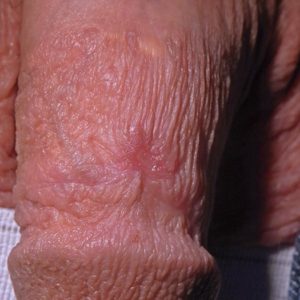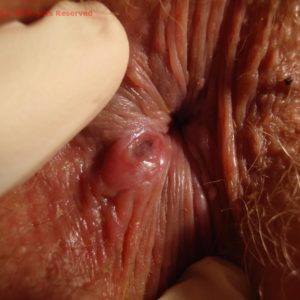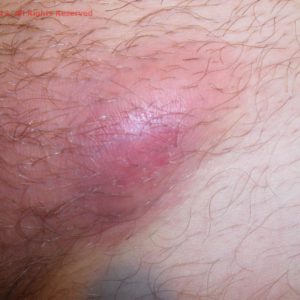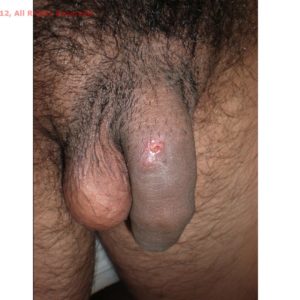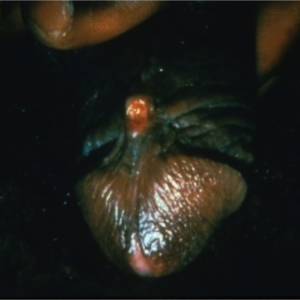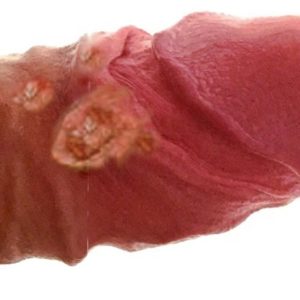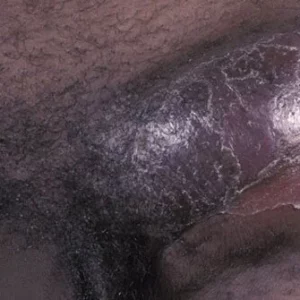Lymphogranuloma Venereum (LGV)
Lymphogranuloma venereum (LGV) is rare in Australia. LGV is endemic in parts of Africa, Asia, South America and the Caribbean, but since 2003 has been increasingly recognised in Europe, North America and Australia. In Australia, it is still an uncommon disease, usually presenting as proctitis (inflammation of the rectum causing pain and bloody diarrhoea) in men who have sex with men.
What is LGV?
LGV is a curable sexually transmitted infection that causes small, often asymptomatic skin lesions, followed by swelling of the infected area. It can infect the genitals, anus, rectum, throat and lymph glands. LGV can be transmitted even when the person with LGV has no symptoms.
LGV is caused by a particular strain of chlamydia bacteria and spreads through unprotected anal, oral or vaginal sexual contact, especially if there is broken or damaged skin. In Australia, LGV is most common in men who have sex with men (MSM) who have condomless anal sex with multiple sexual partners.
Having LGV can increase the risk of contracting other STI/BBV, including hepatitis, syphilis, gonorrhoea, and HIV.
Lymphogranuloma venereum (LGV) is rare in Australia. LGV is endemic in parts of Africa, Asia, South America and the Caribbean, but since 2003 has been increasingly recognised in Europe, North America and Australia. In Australia, it is still an uncommon disease, usually presenting as proctitis (inflammation of the rectum causing pain and bloody diarrhoea) in men who have sex with men.
What is LGV?
LGV is a curable sexually transmitted infection that causes small, often asymptomatic skin lesions, followed by swelling of the infected area. It can infect the genitals, anus, rectum, throat and lymph glands. LGV can be transmitted even when the person with LGV has no symptoms.
LGV is caused by a particular strain of chlamydia bacteria and spreads through unprotected anal, oral or vaginal sexual contact, especially if there is broken or damaged skin. In Australia, LGV is most common in men who have sex with men (MSM) who have condomless anal sex with multiple sexual partners.
Having LGV can increase the risk of contracting other STI/BBV, including hepatitis, syphilis, gonorrhoea, and HIV.
Signs and Symptoms
If you get symptoms of LGV, they will usually appear within 3-30 days of exposure. If left untreated, LGV can lead to a range of severe complications. LGV can be transmitted even when the person with LGV has no symptoms.
Vagina/Vulva
If signs or symptoms are present, there may be:
- Small, painless ulcers
- Swelling and redness of the skin in the groin area
- Swollen lymph nodes (glands) on one or both sides of the groin
- Lower abdominal pain
- Swelling of the labia
- An ongoing and untreated infection may also lead to genital ulcers, followed by general inflammation of the affected area, painful lymph node swelling (known as bubo formation) and/or fever, arthritis, pneumonitis, or reactive arthritis.
Penis
If signs or symptoms are present, there may be:
- Small, painless ulcers
- Swelling and redness of the skin in the groin area
- Swollen lymph nodes (glands) on one or both sides of the groin or the rectum
- Lower abdominal pain
- An ongoing and untreated infection may also lead to genital ulcers, followed by general inflammation of the affected area, painful lymph node swelling (known as bubo formation) and/or fever, arthritis, pneumonitis, or reactive arthritis.
Anus/Rectum
If signs or symptoms are present, there may be:
- Small, painless ulcers
- Swollen lymph nodes (glands) on one or both sides of the rectum
- Blood, mucus or pus from the rectum, or blood in your faeces
- Painful bowel movements or a feeling of incomplete emptying after bowel movements
- Diarrhoea and lower abdominal pain
- An ongoing and untreated infection may also lead to inflammation of the lining of the rectum (known as symptomatic proctitis) and/or fever, arthritis, pneumonitis, or reactive arthritis
Throat
If signs or symptoms are present, there may be:
- Inflammation of the back of the throat
- Ulcers
- Sore throat
- Swollen glands in the neck
Lymph glands
If signs or symptoms are present, there may be:
- Swelling and redness of the skin in the groin area
- Swollen lymph nodes (glands) on one or both sides of the groin or the rectum
- Lower abdominal pain
- An ongoing and untreated infection may also lead to ulcers, followed by general inflammation of the affected area, painful lymph node swelling (known as bubo formation) and/or fever, arthritis, pneumonitis, or reactive arthritis
An advanced LGV infection may lead to:
- Chronic inflammation and breakdown of affected tissue
- A narrowing of the end of the anal canal (rectal stricture)
- Tissue death (necrosis)
- Rupture of the lymph nodes
- Abnormal tunnels between the vagina and rectum (fistulas)
- Tearing (perforation)
- Scarring
- Systemic complications like pneumonia and hepatitis
Symptom Images (content warning: click or tap to expand)
Transmission
- LGV is spread through unprotected anal, oral or vaginal sexual contact, especially if there is trauma or breakage to the skin or mucous membranes.
- Sharing sex toys without cleaning or changing condoms between partners can also spread LGV.
LGV can be spread even when the person with LGV has no symptoms.
LGV is more common in parts of Africa, India, Southeast Asia, Latin America and the Caribbean. People who travel to countries where LGV is more common and have unprotected sex with someone with the infection may also be at risk.
Prevention
- Using condoms and other barriers like gloves or dams
- Covering anything which is moved from one anus or vagina to another with a fresh condom (including sex toys)
- Using condoms and dams for oral sex
- Using a new glove between partners when fingering or fisting
- Using condoms when sharing sex toys or clean silicone, metal, ABS plastic or glass toys with warm water and anti-bacterial soap
- Avoiding sharing enema equipment
It is recommended that you always change condoms when going from anal to vaginal or oral sex.
Testing
Here’s some information about testing for LGV. You can view a list of sex worker-friendly sexual health clinics on our Where To Test page.
Testing method
- Testing is done with a swab and will be collected by your doctor or nurse. The test will be for chlamydia.
- If the chlamydia test is positive, the laboratory will test the sample for LGV. All people who test positive for anal chlamydia will be given 7 days of doxycycline and told that if the LGV swab returns positive, they will need 21 days of treatment.
When to Test
- It is best to get tested for LGV if you have symptoms or have a sexual partner who has had LGV.
- LGV is not part of a routine sexual health screening, so you will need to talk to your doctor or nurse about your symptoms, and they will order the test if they think you may have LGV.
Other Info
- Sexual health clinic testing is often bulk billed, even if you don’t have Medicare, so the test will most likely be free.
- You may pay a fee or be bulk billed if you see a GP.
Treatment
LGV is treatable and curable.
Treatment Method/s
- A three-week course of antibiotics is generally effective.
- If you have painful or swollen lymph nodes, they may need to be drained using a needle.
- You can get LGV again after treatment – no immunity is created by having it once.
- Getting another sexual health screen three months after being treated for LGV is a good idea to make sure that your treatment has been successful.
Costs and other information
- The cost of antibiotics for treating an STI such as LGV ranges from $10-20 on the Pharmaceutical Benefits Scheme (PBS).
- If you have a healthcare card, you will usually only pay the dispensing fee of about $6.
- Your GP can tell you more about what costs to expect.
- Public sexual health clinics can provide treatment for LGV, regardless of your Medicare eligibility.
- You have a higher risk of becoming reinfected with LGV or getting another STI for the first year after an LGV infection.
How might this impact my work?
Practical considerations
- Doctors recommend avoiding sexual contact until after your 21-day course of antibiotic treatment.
- If you cannot afford to take this time off work, consistent condom use can offer some protection from transmitting LGV while receiving treatment. You may also consider offering alternative services or doing non-contact sex work like phone sex or online work.
- Having LGV can increase the risk of contracting other STIs, including HIV, hepatitis, syphilis, and gonorrhoea. Condoms are your best defence!
- Ongoing and advanced infections can lead to severe tissue damage to the affected area and may require surgery, so get medical care quickly.
- If you often get thrush when you take antibiotics, you may want to take probiotics during and after your treatment to help prevent this.
Legal and reporting considerations
- Some states and territories may have laws that criminalise sex working or having sexual contact while you have a BBV or STI. Check out our BBV, STI and the Law resource or contact your local sex worker peer organisation for more information.
- Contact tracing of previous sexual partners (known as ‘partner notification’) is a consideration for some BBV and STI. It should be done with consideration of the unique transmission risk and privacy needs of sex workers. Your local sex worker peer organisation can advise on any partner notification process to ensure it is appropriate for your circumstances.
- LGV is a routine notifiable condition in some jurisdictions, which means that diagnosed cases of gonorrhoea are confidentially reported to state or territory health departments. You can find more information on the requirements for your jurisdiction on our BBV, STI and the Law resource.
You Might Also Be Interested In…
What are BBV & STI?
Lorem ipsum dolor sit amet, consectetur adipiscing elit, sed do eiusmod tempor incididunt ut labore et dolore magna aliqua. Ut enim ad minim veniam, quis nostrud exercitation ullamco laboris nisi ut aliquip ex ea commodo consequat.
Testing Timeframes
Lorem ipsum dolor sit amet, consectetur adipiscing elit, sed do eiusmod tempor incididunt ut labore et dolore magna aliqua. Ut enim ad minim veniam, quis nostrud exercitation ullamco laboris nisi ut aliquip ex ea commodo consequat.
Alternative Services
Lorem ipsum dolor sit amet, consectetur adipiscing elit, sed do eiusmod tempor incididunt ut labore et dolore magna aliqua. Ut enim ad minim veniam, quis nostrud exercitation ullamco laboris nisi ut aliquip ex ea commodo consequat.
Testing Locations
Lorem ipsum dolor sit amet, consectetur adipiscing elit, sed do eiusmod tempor incididunt ut labore et dolore magna aliqua. Ut enim ad minim veniam, quis nostrud exercitation ullamco laboris nisi ut aliquip ex ea commodo consequat.






